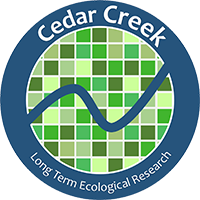This experiment was established in November of 1990. It involved placing over a thousand preweighed and labeled oak and birch dowels in the field across the Cedar Creek landscape. The purpose is to measure the decomposition potential using a uniform common substrate across Cedar Creeks broad range of ecosystems.
Each of the 27 sites have 11 above and 11 belowground dowels of birch and the same number of red oak. This allows for two samples the first year and one per year thereafter for 10 years. Each dowel is 12.7cm long and 1.27cm in diameter. Each dowel is preweighed and tagged. Belowground dowels are driven into the ground vertically and tethered to two pieces of rebar (birch on one, oak on the other) located about a meter apart. Aboveground dowels are laid on top of existing litter and are tethered to the rebars. Resin bags are tethered to the rebars and buried in the upper soil (ca. 5cm).
Replicate sets of dowels and ion exchange resin bags (to measure N availability) were placed in 9 grassland, 9 forest, and 9 wetland sites. All 27 sites are in or adjacent to already established LTER plots. The first samples were collected in May 1991.
On May 5, 1995, a wildfire burned completely through field B where some of experiment 88 was located.
